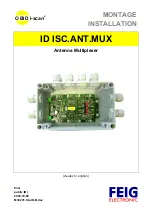
Signametrics
22
4.2.9 Cleaning Relays Contacts
Using the
SCANCleanRelays()
function, the Scanner can clean each relay contact. It does this using a specially
designed on-board stimulus source along with a series of vibrations. This operation causes deposits of contaminants
such as polymer deposits as well as oxides to be removed. It also solves a common relay problem involving thin
film of insolationg deposits, which accumualte particularly on relays which have not been used for a while. It does
this by pinching through this film using an on-board high voltage souce. Performing this function on a regular basis
will improve the scanning system’s reliability and repeatability,as well as prolong contact life. All relays including
Channel relays, Configuration relays and Treeing relays are cleaned by this function. The test connector must be in
place in order to perform this operation. This function returns an error if the test connector is abscent. Cleaning
takes about 13 seconds for the SM404X and a bit less for the SM402X
4.2.10 Integrity Test
The Integrity test is a quick verification tool. The
SCANTestChanIntegrity()
function tests the integrity of the
specified channel relay, by verifying that the currently set actuation and release times are adequate. The release time
is assumed to be 1/2 of the actuation time. This procedure closes the relay, waits for a time equal to the actuation
time, then it tests for contact closure on both contacts. Next it opens the channel relay, waits for a period equal to
the release time, and verifies that the relay is open.
This test does not include bounce test. Use the
SCANTestChannelRelay()
and
CANTestConfigRelay()
functions
for a more comprehensive test. This test does not verify bounce
The test connector must be present in order to carry this operation. If the test connector is not present, this function
returns an error. Cleaning takes about 13 seconds for the SM404X and a bit less for the SM402X
4.2.11 Self Tests
These comprehensive tests consist of the Channel Relays test and the Configuration Relays test. They provide the
confidence of knowing that the Scanner is in good repair, and can continue in its operation. The two tests are
applied to a single channel: configuration or tree relay. These tests diagnose excessive bounce, open failure, and
short failure. If no failure is detected, these functions measure and return the actuation time for the selected relay.
The actuation time measured includes closure time plus bounce time. The results of these tests can be used to fine
tune the scanner for maximum switching time performance by either, setting the highest relay’s actuation time
(using the
SCANSetActuationTime()
function), or setting individual actuation time prior to selecting each channel.
The value of the measured actuation time is an indicative of the condition of the selected relay. A value higher than
that specified for the Scanner is an indication of relay deterioration, which may require relay replacement. These
tests require the test connector.
Channel Relays Test
Each Channel may be tested using the
SCANTestChannelRelay()
function. The Channel parameter can be a value
between 1 and 40 for the SM4040 and SM4042, and 1 to 20 for the SM4020 and SM4022. If no failure is detected,
this function returns the Actuation time for the relay.
Configuration Relays Test
Each Configuration and Tree relay may be tested using the
SCANTestConfigRelay()
function. Configuration relay
can be AtoA, BtoA, BtoB, CtoA, CtoC, DtoA, DtoC, or DtoD for the SM4040 and SM4042. For the SM4020,
SM4022 it can be AtoA, BtoA, or BtoB. See the
ScanUser.H
file for definitions of these relays. . If no failure is
detected, this function returns the Actuation time for the relay.
4.2.12 Setting Actuation Time Parameter
The Actuation time includes the time a relay closes and settles. It is made up of both, the Operate time and Bounce
time. Each relay has different actuation time, and therefore it is a good idea to keep the default 10ms Actuation time.
Alternatively, one can measure all relays, and set the Actuation time to the slowest relay of the Scanner. Actuation
time may vary with age, and could be an indication of fatigue of the relay. Configuration and Tree relays may be
Содержание SM4020
Страница 61: ...Signametrics 60...
















































